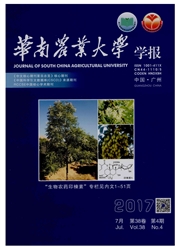

 中文摘要:
中文摘要:
【目的】为了解不同供氮水平培养的水稻植株对盐胁迫的响应.【方法】以2个北方常规粳稻品种为材料,在5个供氮水平下培养至孕穗期,以3个盐浓度进行胁迫处理,研究了处理后的水稻植株生物量、光合特性及一些生理特性的变化.【结果和结论】不同供氮水平培养的水稻植株在盐胁迫后生物量均呈下降趋势;盐胁迫下,2个水稻品种的净光合速率(Pn)、气孔导度(Gs)、蒸腾速率(Tr)和表观叶肉导度(AMC)显著下降.低氮水平培养的水稻植株在盐胁迫后净光合速率下降的原因是由非气孔限制因素引起的,而高氮水平下其在盐胁迫后净光合速率下降的原因还增加了气孔限制因素.在盐胁迫下,1/2N水平下水稻的叶片抗氧化酶SOD、POD、CAT活性及植株体内脯氨酸、可溶性糖含量显著高于其他N水平,膜透性和丙二醛含量均低于其他N水平.1/2N水平的营养液培养水稻可提高水稻的渗透调节能力,从而增强其在孕穗期的抗盐能力;九稻13号的耐盐性高于吉粳88号.
 英文摘要:
英文摘要:
【Objective】To understand the response to salt stress on rice varieties cultured at different nitrogen levels. 【Method】Two north japonica rice varieties were cultured at five nitrogen levels of nutrient solution until booting stage,the changes of biomass,photosynthetic characteristics and some physiological characteristics of two rice varieties were measured in three salt concentrations. 【Result and conclusion】The biomass of rice varieties which were cultured at different nitrogen levels of nutrient solution decreased under salt stress; there were significant decrease in net photosynthetic rate( Pn),stomatal conductance( Gs),transpiration rate( Tr) and apparent mesophyll conductance( AMC) of rice leaves under salt stress. The Pn reduction was due to non-stomatal restriction factors in low-nitrogen-level nutrient solution,however,the stomatal and non-stomatal limitation factors resulted in the Pn reduction in high-nitro-gen-level nutrient solution. Under salt stress,the activity of antioxidant enzymes such as SOD,POD and CAT,the contents of proline and soluble sugar of leaves in 1 /2N-level nutrient solution were significantly higher than those at other nitrogen-levels,the membrane permeability and the content of MDA in 1 /2Nlevel were lower than those at other nitrogen-levels. The results show that rice varieties cultured in 1 /2Nlevel nutrient solution can improve the capacity of osmotic regulation,enhancing the salt-tolerance ability of rice varieties at booting stage. The capacity of salt-tolerance of Jiudao13 is higher than that of Jijing88.
 同期刊论文项目
同期刊论文项目
 同项目期刊论文
同项目期刊论文
 期刊信息
期刊信息
